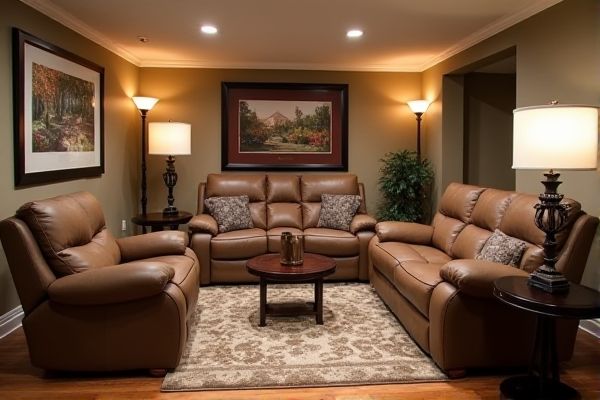
Choosing between a recliner and a loveseat for your basement depends on your space, comfort needs, and usage patterns; recliners offer personalized comfort and relaxation, while loveseats provide seating for two and save space. Explore the rest of the article to determine which option best enhances your basement's comfort and functionality.
Table of Comparison
| Feature | Recliner | Loveseat |
|---|---|---|
| Purpose | Individual seating with reclining function for comfort | Seating for two people, designed for space efficiency |
| Seating Capacity | 1 person | 2 people |
| Comfort | High, with adjustable backrest and footrest | Moderate, cushioned but non-reclining |
| Space Requirement | Requires more room for reclining | Compact, fits well in small basement spaces |
| Usage in Basement | Ideal for relaxation zones, movie watching | Good for casual seating, socializing |
| Style Options | Varies: leather, fabric, modern to classic | Varies: fabric, leather, modern and traditional |
| Price Range | Typically higher due to mechanics | Generally more affordable |
Introduction: Recliner vs Loveseat for Your Basement
Choosing between a recliner and a loveseat for your basement depends on space, comfort, and functionality. Recliners offer personalized relaxation with adjustable seating and are ideal for individual lounging, while loveseats provide seating for two, optimizing space without compromising comfort. Basement layouts with limited room benefit from loveseats, whereas larger areas accommodate multiple recliners for versatile seating arrangements.
Space Efficiency: Maximizing Basement Layout
Choosing a loveseat for your basement maximizes space efficiency by offering compact seating without overwhelming the layout. Recliners require more room due to their extended footrests and reclining mechanism, which can limit movement in tighter spaces. Prioritize your basement's flow by selecting a loveseat that optimizes seating capacity while preserving open areas for versatility.
Comfort Comparison: Recliner vs Loveseat Experience
Recliners provide superior personalized comfort with adjustable reclining positions and built-in footrests, ideal for long-term relaxation in a basement setting. Loveseats offer cozy seating for two with cushioned support, promoting social interaction but less adaptability in comfort compared to recliners. The choice depends on whether individual ergonomic comfort or shared seating experience is prioritized for basement living spaces.
Style and Aesthetic: Matching Basement Decor
Choosing between a recliner and a loveseat for your basement depends heavily on your style and aesthetic preferences. Recliners offer a cozy, individual seating option that suits casual, relaxed environments, while loveseats provide a more structured, streamlined look that complements modern or traditional decor. Your basement's design theme and available space will guide whether a recliner's comfort or a loveseat's cohesive appearance better enhances the overall ambiance.
Functionality and Features: What Each Offers
A recliner offers individualized comfort with adjustable backrests and footrests designed for relaxation, ideal for single users seeking ergonomic support. A loveseat provides seating for two, emphasizing shared space and social interaction with compact dimensions suitable for basement settings. Both pieces optimize basement functionality by balancing comfort and space efficiency, with recliners focusing on personalized comfort and loveseats promoting togetherness.
Seating Capacity: Hosting Family and Friends
Recliners typically offer individual seating with enhanced comfort, making them ideal for personal relaxation in the basement. Loveseats provide seating for two people, optimizing space while accommodating couples or small groups during gatherings. Selecting a loveseat can maximize seating capacity in basement entertainment areas, whereas multiple recliners better serve scenarios requiring ample personal comfort.
Budget Considerations: Cost Differences
Recliners typically cost more than loveseats due to their mechanical components and added comfort features like reclining mechanisms and built-in footrests. Loveseats, with simpler designs and fewer moving parts, offer a more budget-friendly option for basement seating without sacrificing style or seating capacity. You can balance your basement's comfort and budget by choosing a loveseat when cost efficiency is a priority, while recliners provide enhanced relaxation at a higher price point.
Durability and Maintenance in Basement Environments
Recliners designed with durable, moisture-resistant materials such as faux leather or treated fabrics perform better in basement environments prone to humidity and temperature fluctuations. Loveseats with sturdy frames made from hardwood or metal offer enhanced structural longevity, reducing wear and tear in damp conditions. Regular maintenance, including vacuuming and using dehumidifiers, helps preserve both recliner and loveseat upholstery, extending lifespan and retaining comfort in basements.
Entertainment and Home Theater Use
A recliner offers personalized comfort with adjustable positions, making it ideal for immersive home theater experiences in your basement. Loveseats provide cozy seating for two, enhancing social interaction during movie nights or gaming sessions. Choose a recliner for individual relaxation or a loveseat for shared entertainment, optimizing your basement's functionality.
Final Verdict: Choosing the Best for Your Basement
Selecting between a recliner and a loveseat for your basement depends on space, comfort needs, and intended use; recliners offer superior individual relaxation and adaptability, while loveseats provide shared seating and a cozy atmosphere. Consider the basement's dimensions and your lifestyle preferences to determine whether personal comfort or social seating is more important. Your decision ultimately hinges on balancing functionality with the ambiance you want to create in your basement space.
 homyna.com
homyna.com